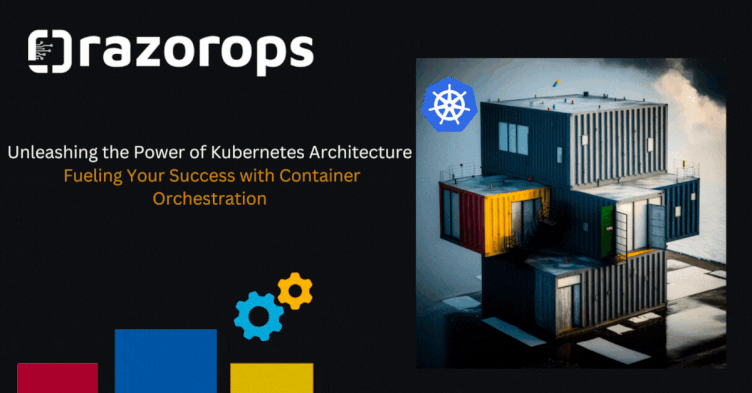
Unleashing the Power of Kubernetes Architecture Fueling Your Success with Container Orchestration
Software development and deployment, containerization and orchestration have emerged as game-changing technologies. Among these, Kubernetes stands out as a powerhouse for managing and orchestrating containerized applications. The architecture and capabilities of Kubernetes make it a critical tool for organizations aiming to optimize their infrastructure and accelerate their path to success. In this blog post, we will delve deep into the world of Kubernetes architecture and explore how it can supercharge your container orchestration efforts.
Understanding Container Orchestration
Before we dive into the intricacies of Kubernetes, let’s briefly review the concept of container orchestration. Containerization technology, led by Docker, allows developers to package applications and their dependencies into containers. These containers can be deployed consistently across different environments, ensuring that an application behaves predictably and reliably, regardless of where it is run.
Container orchestration, on the other hand, is the process of automating the deployment, scaling, and management of these containers. It ensures high availability, load balancing, and efficient resource utilization, making it an essential part of modern cloud-native architecture.
Kubernetes: The Orchestration Maestro
Kubernetes, often abbreviated as K8s, is an open-source container orchestration platform that was originally developed by Google and is now maintained by the Cloud Native Computing Foundation (CNCF). Kubernetes’ architecture is a shining example of the power of open-source collaboration and the result of years of development by a vibrant community of developers.
At its core, Kubernetes offers a set of abstractions for deploying and managing containerized applications. These abstractions include Pods, Services, and Deployments, among others, that simplify the management of complex applications. The architecture of Kubernetes consists of a master node and multiple worker nodes, forming a cluster.
Let’s take a closer look at these components:
Master Node
API Server: Acts as the entry point for controlling the cluster and serves as the primary management component.
Etcd: A distributed key-value store that stores the cluster’s configuration data and the state of all objects in the cluster.
Controller Manager: Enforces the desired state of the system by controlling various controllers such as ReplicaSet, Deployment, and StatefulSet.
Scheduler: Assigns work to worker nodes based on resource availability and constraints.
Worker Node
Kubelet: Ensures containers are running in a Pod, reports their status, and takes necessary actions if any issues arise.
Container Runtime: Manages the containers, commonly Docker or containerd.
Kube Proxy: Maintains network rules on the host and enables communication to and from the Pods.
Pods: The smallest deployable units in Kubernetes, Pods can host one or more containers, sharing the same network and storage.
Benefits of Kubernetes Architecture
Scalability: Kubernetes allows you to scale your applications up or down effortlessly. It ensures your application can handle increased traffic and scale back during periods of low demand.
High Availability: Kubernetes provides automatic failover and load balancing, guaranteeing that your application is always available, even when individual containers or nodes fail.
Resource Efficiency: By efficiently distributing workloads across your cluster, Kubernetes optimizes resource utilization, saving costs and enhancing performance.
Self-Healing: Kubernetes constantly monitors the state of your applications and takes necessary actions to ensure they are healthy, minimizing manual intervention.
Portability: With Kubernetes, your applications can run consistently across different cloud providers or on-premises environments, making it an excellent choice for hybrid or multi-cloud strategies.
Fueling Your Success with Kubernetes
Now that we’ve covered the basics of Kubernetes architecture, let’s explore how it can fuel your success in the world of container orchestration:
Rolling Updates: Kubernetes supports rolling updates, enabling you to deploy new versions of your applications without service interruptions.
Resource Efficiency: Kubernetes optimizes resource allocation, which can lead to cost savings in cloud environments.
Ecosystem and Community: Kubernetes has a vibrant ecosystem and a large community, providing a wealth of resources, tools, and best practices to support your journey.
Flexibility and Portability: Kubernetes runs on various cloud providers and on-premises, offering flexibility and portability for your applications.
Security: Kubernetes provides robust security features to protect your applications and data.
Kubernetes architecture is the key to unlocking the potential of container orchestration. It empowers organizations to streamline their operations, increase application availability, and take full advantage of cloud-native technologies. By understanding the core components and benefits of Kubernetes, you can harness its power to fuel your success in the world of container orchestration. Whether you’re a startup looking to scale rapidly or an enterprise aiming to modernize your infrastructure, Kubernetes is your ticket to achieving container orchestration excellence.
Tutorials & Guides
Top Reading Recommendations
Container Orchestration Comparison on Stackify
Upcoming Events
Keptn Public Technical Committee meeting
Nov 08 – 02:30 - 3.15 PM (PST)
Pravega Community Meeting
Nov 08 – 8:30 –9:30 PM (PST)
OpenFeature Community Meeting
Nov 09 – 08:30 - 9:30 PM (PST)
Nov 3, 10:30 – 11:30 PM
DevOps Jobs
Google - Check out all the jobs
here
Accenture -Check out all the jobs here
Infosys -Check out all the jobs here
Microsoft -Check out all the jobs
here

PS- We publish this newsletters every week, Subscribe and share with your friends. We hope this newsletter has provided valuable information. Follow RazorOps Linkedin Page Razorops, Inc.





